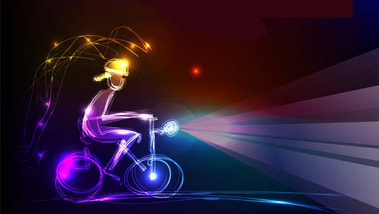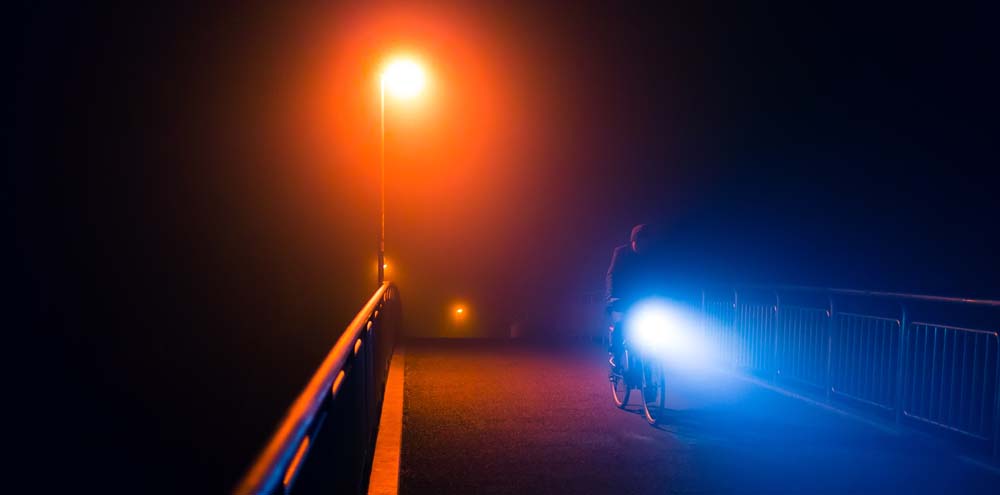 Bike lights have two purposes: to see where you are going and to be seen by others. There is a misconception that if you ride a bike in the city you do not need bright lights because there is ambient lighting from street and car lights which allows you to see and be seen. While any small powered bike light is better than nothing, a bright light will improve your safety by extending your ability to be seen from a greater distant and providing better illumination of the road. What is a Bike Light A bike light is a special purpose light designed to be attached to a bicycle or some equipment used by a rider, such as a helmet, jacket, bike bag, or bike rack, whose purpose is to improve the visibility of the bicycle and its rider and to illuminate the road so the rider can see a greater distance. Many cities require one or more bicycle lights instead of, or in addition to, reflectors to be used on a bicycle at night — generally a white light in the front and a red light in the rear, as is required with other vehicles on the road. While legally a light might be required only at night, there is evidence that running lights even in the daytime makes a cyclist more visible and reduces crashes. Daytime running lights are especially beneficial in fog and cloudy conditions. How to See Where You are Going If you’ve ever biked in a section of road where the street lights are out you know how difficult it is to see where you are going, see enough of your surroundings to avoid a crash with other cyclists, pedestrians, and drivers, and avoid potholes in the road. Some trails out in nature are not well lit, if at all, and you will not know when the path turns or there are hazards. A bright light will solve these problems. How to Help Others See You You are usually not the only one on the road and others need to be aware of your presence to know how close you are. Bicycle lights will let your location be known so other road users can be more careful. How Bright Should a Bike Light Be There have been a lot of advances in light technology since the oil-based lamps that were used on early high wheel bicycles. Other technologies that have been used over the last 100 years include acetylene gas lamps, and incandescent bulbs powered by dynamos, lead-acid batteries, dry cells, and alkaline batteries. Eventually incandescent bulbs were replaced by halogen lamps and light emitting diodes (LEDs) and LEDs are now the most popular because they are bright, long lasting, and require less power to operate. LEDs are measured in lumens, which is technically defined as: Lumen is a unit of luminous flux in the International System of Units, that is equal to the amount of light given out through a solid angle by a source of one candela intensity radiating equally in all directions.” Basically, lumens are a measurement of brightness. This is different than watts, the measurement of traditional incandescent bulbs, which is a measurement of the amount of energy in a light and indicates how much energy they use. But more wattage does not actually mean more light unless you are comparing the same type of light bulb. That is why measuring in lumens is a better unit of measure for LEDs than watts. Here are the recommendations for how many lumens you should have in a front light on a bike in various riding environments:
Rear lights do not need to be as bright as front lights because they are there just to help you be seen so 110 to 250 lumens is usually sufficient power. The more lumens you have the further away you will be seen. However, where there is great speed or distance between vehicles a rear light producing lumens on the higher end will allow you to be seen sooner and thus make you safer. Lights that Blind, Flash, and Beam Configuration
Blinding Lights - If you are concerned a light with 600 lumens or more on the front will be too bright and be blinding and hazardous if pointed into the eyes of other users, it need not be if precautions are taken. Most bike lights have multiple modes and you have the flexibility to select the brightness and flashing pattern consistent with the environment you are in. If you do have a powerful light and are cycling directly past other cyclists and auto traffic, it is a good idea to point the light down slightly so it does not meet the eyes of others and blind them. Flashing Lights - Some front and rear bike lights have a flashing mode and there is controversy around using that option. Studies show a flashing light attracts more attention and makes you more visible than a steady light and it also uses less battery power so you won't run out on long rides, but on the other hand it is harder to estimate the position of a bike from a flashing light. A flashing light is generally considered useful during the day when it’s overcast and gray or in the rain. If you have a light with less than 50 lumens, there’s probably a case for using the flash mode to attract more attention because the light itself does not have the power to be seen very far. If you are having trouble deciding whether to flash to not, a compromise is to have two front lights--one flashing to grab attention and another one steady to improve distance estimates. Beam Configuration - You can find out the number of lumens a light has by what is says on the packaging, but there is another differentiator between front lights--whether the beam is narrow and focused which is beneficial for "seeing" versus shallow and dispersed which is preferable for "being seen." This information is not readily available on light packaging and only discoverable by digging into the documentation. Both beam types are legitimate for different types of riding situations. If you are using a two front light configuration, either two on a handlebar or one on a handlebar and one on a helmet, one of each beam configuration would be ideal. As far as which is the best light, there are so many to choose from, and they are all pretty equivalent, with differences being small and only worth researching if you want to drill down to purchase a light optimized for a specific use. You can't go wrong by selecting a well known brand with a reputation for quality optics, construction, water resistance, and flexible attachment mechanisms and purchasing the most lumens your budget can afford. Comments are closed.
|
Earth Rider Blog about CycingAuthorSharon Kaminecki and others comment on adventures in bicycling and other stories Categories
All
Archives
August 2023
|




